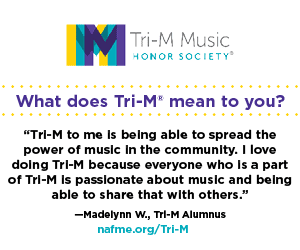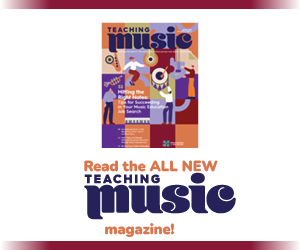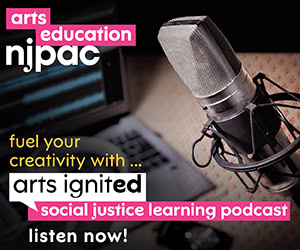/ News Posts / 6 Strategies to Boost Musicianship
6 Strategies to Boost Musicianship in General Music through Piano Partner Learning
By Elana Master and Ariana Bell
This blog is sponsored by NAfME Corporate Member Music and the Brain.
Loved School-Day Music Class, Lacked Literacy
I arrived at middle school with so much excitement to join the musical groups, chorus, and orchestra, but soon faced a harsh reality. The expectations for my musical literacy were far beyond what I had been prepared for. I had general music class throughout elementary school, my father was a musician, and my parents offered me private piano lessons at age 7, though they didn’t work for me. I understood how rhythm worked, and I could manipulate my voice in any way. Music moved me, and I loved it. Music was my life. After all, I had a great ear. In chorus, I could get by with generally reading the contours of the melody, and leaning on my good ear.

However, the truth of the matter was, I could hardly read music. Yes, I knew Every Good Boy Does Fine, but this was separate from playing music somehow. It wasn’t integrated and applied. The names of all the notes were written under the violin II part of the pieces I was to learn.
I was left behind as my classmates excelled. Many having had private lessons, they were playing the music with ease. My stand partner, Nina, and I sat quietly in the back of the section, with uncertainty, hoping no one would notice us, or, our sheet music covered with the alphabet.

Years into playing, my skills grew, but I was always at a disadvantage. In college, I studied music and vocal performance, feeling insecure about my musicianship, wondering if I would always be this way. I pushed myself, and it wasn’t until the piano class that I truly was forced to move beyond my disadvantaged mindset, and practice often to truly read the music, and perform with musicality and confidence. Learning this instrument shifted everything.
Through this experience grew a passion for music literacy for all, and from a young age. I began teaching piano lessons to young 5 year olds, and eventually became a music teacher. Luckily, I landed an excellent job at a school that wanted me to teach the whole class piano. They were using a curriculum called Music and the Brain (MATB) shaped by hundreds of music teachers for decades. I immediately said yes and wasn’t sure what to expect, but I hoped this would make a profound difference for my students. My students would not be the ones to show up to middle school as musically insecure and illiterate. Instead, they would be well equipped, as true musicians, who would have the tools to perform, learn, and grow.

5 Truths I Learned from Teaching Piano as a Foundation within General Music Lessons
1. Piano Musicianship for All Is a Gateway
Along with building a lifelong appreciation for music, learning piano as an early instrument offers a substantial set of transferable skills for all other instruments, as well as composition.
- Elementary school piano learning for all helps students enter middle and high school musical groups with an upper hand.
- Examples: Students have gone to arts-based high schools like the famed La Guardia High School in NYC, and some have gone on to perform on Broadway.
2. Piano Partner Practice = Perseverance
Students gained the benefit of an iterative or growth mindset, focus and were intrinsically motivated.
- Piano practice takes time and effort before finding ease. Overcoming struggle is a skill that is applied to all aspects of their lives, social-emotionally, and in other subjects in schools like Math and ELA. Students learned to view obstacles as opportunities for growth.
3. Scaffolded Music Literacy Is Fun!
My students developed a base in music literacy and analysis from the earliest grades.
- Students build their analytical brain and fine motor skills by first reading the notes, examining directionality, fingering, and rhythm, then easing them into letter names gradually.
- Students analyzed and played lots of repertoire and expanded their understanding incrementally with each lesson.
4. An Integrative Approach Is King
Students listened, read, sang, moved, and played!
- My previous focus on thematic or modular lessons limited the integration of skills and a broader development of my students’ musical minds.
- Over multiple years students developed and applied their knowledge through fun lesson activities away from the keyboards, which led to focused piano practice and performance time each week.
5. The Power of Cross-Curricular Music Learning
Cross-curricular connections are embedded through the contours of the repertoire in the Music and the Brain approach.
- Internalization of the repertoire through singing, moving and context is emphasized in each lesson, while practicing the piano is the application of what has been learned.
- My lessons contributed more deeply to the overarching concepts and learning within the general classroom, catching the attention of colleagues and administrators.
6 Strategies I Learned through Music and the Brain to Implement Piano Learning in General Music Lessons
A piano lab setup alone will only get you so far. The scaffolded and multimodal curriculum that Music and the Brain provided me, along with robust professional development and support, truly helped my students soar. Lessons are based on a repertoire of hundreds of songs, with sequential concept integration, with proven diverse lesson activities for students including singing, movement, and analysis of history, cultural connections, genre, notation, and musical interpretations.
1. Strong Structure Leads to More Engagement
Having a structured lesson routine offers predictability and safety for the students while keeping each lesson fresh with a new piece to learn.
- Routines and structures in the classroom will automatically lessen the need for behavior management interventions and increase student engagement.
- My students knew from the moment they entered the room that we had a destination, and they were eager to go.
2. Work Smarter, Not Harder- Multi-Year Curriculum Allows Teachers to Teach
Utilizing the MATB sequential approach gave me time to actually focus on my students more and be present and in the moment with them.
- I accessed 10,000+ online and physical resources while leaving space for me to be creative.
- Lesson slides, professionally produced audio, and engaging videos are logically accessible, so I don’t have to have so many windows open for one lesson.
3. Multiple Entry Points Offer Something for Every Student
Exploring new pieces through different pathways offers multiple entry points for a diverse group of learners.
- Multi-modal activities (singing, movement, etc) offer a perspective that music is not one-dimensional.
- For the few students who weren’t enthralled with their piano time, they were always engaged at other points in the lesson.
4. Partner Practice, Performance, & SEL
Performance in the classroom can bring joy, excitement, nerves, and the rewards of risk-taking. Music and the Brain taught me to have the students regularly perform for each other on a small scale, so when the performance is on a larger scale, they’ve practiced this too!
- By partnering at the keyboard, students give and receive peer support while practicing.
- I provided students with appropriate language to speak about music and their partner’s practice and how to support them with critical feedback.
- When it came time to have class wide performances, there was less hesitation and more motivation to perform.
5. Activating Student-Led Analysis
One of my favorite parts of teaching music literacy is watching my students analyze their music.
- Music and the Brain analysis tools were among the most fun parts of the lesson and easily led to student-led discussion.
- Administrators often struggle to see the comprehensive value in music lessons. My administrators recognized what my students were learning was directly applicable throughout the rest of the school day and their lives.
- Administrators love to share how their music program supports having higher ELA and Math scores.
6. Seamless Critical Thinking Fun
Exploring song context leads to deep thinking about everything from song origin, culture, geography, SEL skills.
- Music and the Brain embeds visuals, historically and culturally relevant videos, and music variations into the lessons.
- There is flexibility in the lesson for me, from one class to the next, to react to my students’ curiosity with MATB content to support their learning in the moment.
- Administrators appreciated that my lessons were not only teaching music, but a broader view of the world, with an application of transferable skills.
Check this out in the larger impact study of Music and the Brain (MATB) by Columbia University Center for Arts Education Research. As a musician I have always been able to see those connections and skills. Teaching while I created my own curriculum was an ask that I don’t believe music teachers should have to tackle by themselves. Luckily, I was given the opportunity to teach through the Music and the Brain curriculum, now in its 27th year, and I couldn’t be happier. I felt so supported in my mission of musical literacy for all.
Click here for a free Poster of C and Middle C position

Uncover the power of school partnerships with Music and the Brain. A national program of the nonprofit Building for the Arts, Music and the Brain is dedicated to empowering students and music teachers nationwide.
Afterward: A Journey from MATB Student to Teacher by Ariana Bell
For as long as I can remember, Music and the Brain has always been a core part of my life and educational journey. When I was in kindergarten, I had my first music class in a room that felt like the most magical place on earth. Filled with keyboards, percussion instruments, beautifully crafted solfège signs and more, the music room in my elementary school was the place to be. I learned the basics of piano and performance etiquette with my first Music and the Brain teacher: how to stand at the keyboard, how to hold my hands in middle C hand position, and how to be a respectful and responsible listener. I was five years old, but the moment that the importance of music was instilled in me, I knew that I’d be a musician for the rest of my life.
My second Music and the Brain teacher, Althea Walker, helped me to take music to the next level, showing me the importance of discipline and consistent practice. There is no feeling like the one of existing in a safe, comforting, and sound-balanced music room. Althea taught me how to be persistent while learning a new piece. She taught me how to be patient as we graduated through each unit of the Music and the Brain curriculum. Each song in the repertoire provided me with a deeper understanding of different cultures around the world, and it showed me ways that I can connect with others through the sound of music. Completing the repertoire was one of the greatest feelings in the world . . . so amazing that I went right back to the beginning of book one and did it all over again. To this day, I still play through the songs of the Music and the Brain curriculum.
Today, I have the honor of being an elementary music teacher, educating students of today with Music and the Brain. The materials that I once learned as a child have grown into a game-changing web platform that keeps learners of today engaged and motivated to learn music. As a teacher of students with exceptionalities, I can honestly say that this chronologically paced music curriculum is suitable for all learners, and it is adaptable to many different scholastic environments. Children all around the world are lucky to learn from such a phenomenal and well-thought-out program.
About the authors:
 Elana Master, M.A., RYT, began her Music Education career in 2008, after earning her B.A. in Vocal Performance at SUNY Stony Brook University, and completing the Advanced Certificate in Music Education Program and her M.A. at Brooklyn College. She has taught students from age 4 into adulthood both in and outside of the classroom since then. She now finds herself excitedly working with Music and the Brain, the beloved program that elevated the students in her classroom for over a decade, as Partner Acquisition. She is also a registered Yoga teacher, also teaching from age 4 to seniors, and is the founder of Healing Yoga with Elana. She can be reached at partnerships@musicandthebrain.org.
Elana Master, M.A., RYT, began her Music Education career in 2008, after earning her B.A. in Vocal Performance at SUNY Stony Brook University, and completing the Advanced Certificate in Music Education Program and her M.A. at Brooklyn College. She has taught students from age 4 into adulthood both in and outside of the classroom since then. She now finds herself excitedly working with Music and the Brain, the beloved program that elevated the students in her classroom for over a decade, as Partner Acquisition. She is also a registered Yoga teacher, also teaching from age 4 to seniors, and is the founder of Healing Yoga with Elana. She can be reached at partnerships@musicandthebrain.org.
 Ariana Bell, B.A., began learning music through Music and the Brain when she was in kindergarten. She quickly progressed through the program, all while realizing that music would be an area that she passionately studied all throughout her scholastic career. She holds a B.A. in Music from the Conservatory of Music at Brooklyn College and is currently pursuing her M.S. in Special Education. Her ultimate goal is to serve students with exceptionalities through social emotional learning and music. Ariana is an elementary school music teacher and runs a non-profit organization called Broadway Bellyboo, where she creates performance and networking opportunities for creatives across the world.
Ariana Bell, B.A., began learning music through Music and the Brain when she was in kindergarten. She quickly progressed through the program, all while realizing that music would be an area that she passionately studied all throughout her scholastic career. She holds a B.A. in Music from the Conservatory of Music at Brooklyn College and is currently pursuing her M.S. in Special Education. Her ultimate goal is to serve students with exceptionalities through social emotional learning and music. Ariana is an elementary school music teacher and runs a non-profit organization called Broadway Bellyboo, where she creates performance and networking opportunities for creatives across the world.
Interested in reprinting this article? Please review the reprint guidelines.
The National Association for Music Education (NAfME) provides a number of forums for the sharing of information and opinion, including blogs and postings on our website, articles and columns in our magazines and journals, and postings to our Amplify member portal. Unless specifically noted, the views expressed in these media do not necessarily represent the policy or views of the Association, its officers, or its employees.
Published Date
October 8, 2024
Category
- Innovation
- Repertoire
Copyright
October 8, 2024. © National Association for Music Education (NAfME.org)





